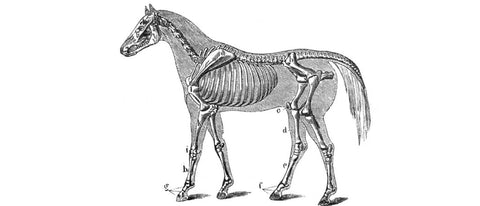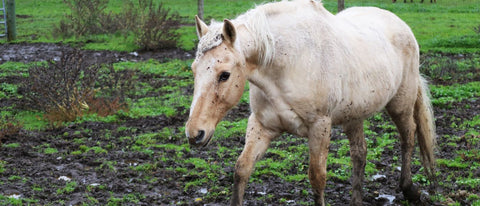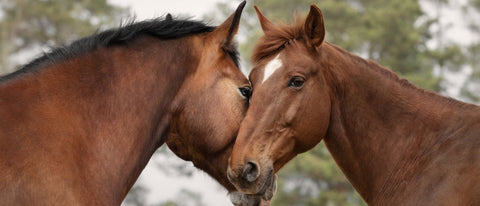
Florian ist aufgewachsen auf einem Bauernhof. Umgeben von Pferden, entdeckte er früh seine Faszination für diese majestätischen Tiere. Inspiriert von seiner reitbegeisterten Mutter, entwickelte er das Nahrungsergänzungmittel - Pferdegold. Seine tiefe Verbundenheit zur Natur und die leidenschaftliche Hingabe zu Pferden trieben ihn an, sein Unternehmen zu gründen.
Are you fascinated by the impressive grace and elegance of your horse?
A horse’s complex bone system makes a significant contribution to these properties.
Not only does it form a protective structure, but it is also crucial for the impressive agility and strength that characterize horses and give them a very special charisma.
In this article, you will receive detailed information about the bone structure of horses, better understand their functions, and learn how you can optimally promote the bone health of your four-legged friend.
We explore the fascinating aspects of the horse skeleton and offer valuable insights that will help us better understand the horse's skeletal system.

Bones in horses: All the facts at a glance
Your horse's bones are much more than just rigid skeletal structures. In fact, they form a dynamic system that continuously regenerates and can adapt to stress.
Here are the main components of a horse bone :
-
Structure: A strong lamellar layer, traversed by a system of tubes through which blood vessels run.
-
Composition: Bones consist of approximately 25% water, 25% organic matter (including the protein ossium) and 50% minerals.
-
Mineral content: In addition to calcium, phosphorus and magnesium, they contain significant amounts of trace elements such as manganese, copper, silicon, boron, iron, potassium, sodium, chlorine and fluorine.
-
Function: The horse's skeleton, consisting of around 250 bones, not only provides protection for internal organs but is also crucial for the horse's mobility and strength.
Interesting to know: Interestingly, some growth plates in the bones of horses do not close until the age of seven , which underlines the importance of adapted training in young years.
These structures of the skeletal system are crisscrossed by nerves and blood vessels, making the bones an essential part of the horse's body.

Perfect for your horse: Pferdegold® supplementary feed!
These specially developed supplements support your horse's diet and provide it with natural nutrients. Made in Germany, grain-free and drug-free, with a 30-day money-back guarantee.
Try it now!The anatomy of the horse: How is the horse's body structured?
The horse's anatomy is a fascinating interplay of bones, muscles, organs, and tissues that function in perfect harmony. These majestic animals are characterized by their strong yet elegant physique , which allows them to develop great power and speed .
The horse's muscular structure is particularly known for its strength and endurance, with the large muscle groups such as those of the back and hindquarters being crucial for movement and carrying loads.
The heart and lungs are housed in the spacious ribcage and are specially adapted to the high demands of endurance and speed. The horse's digestive organs are also remarkable, as they enable efficient processing of food, which is crucial for maintaining their energy and health.
The horse's skin and coat play an important role in protecting it from external influences and regulating its temperature. The sense organs , especially the large and expressive eyes, are important for perceiving the environment and communicating with other horses and humans.
These various aspects of horse anatomy, from muscle strength to organ function to sensory organs, all contribute to horses being considered one of the most versatile and powerful animals.
As we will soon learn in more detail, the bone structure in particular contributes significantly to the functionality and performance of these majestic animals.
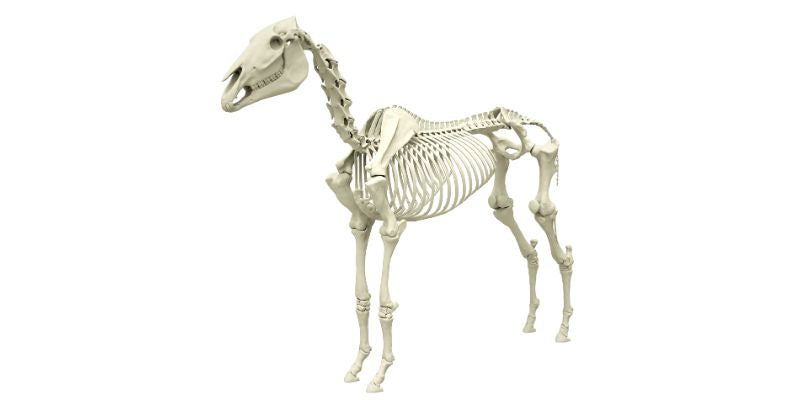
The structure of the skeleton
The skeleton of a horse has a fascinating anatomy and is divided into three main parts : the head skeleton , the trunk skeleton and the limb skeleton .
The head skeleton of the horse
The horse's skull consists of various bony plates that determine the shape of the head. It contains a total of 37 individual bones , some of which are rigidly connected by serrated edges . The cranial cavity provides protection for the delicate brain , supplemented by the frontal sinus , maxillary sinus , and nasal cavity .
The torso skeleton of the horse
These include the spine, ribs, and sternum . The spine consists of various groups of vertebrae, each with differently shaped vertebrae and connected by joints, elastic ligaments, and muscles. It supports not only the weight of the organs, but also the weight of the rider when riding. The rib cage, formed by the spine and 18 curved ribs , provides sufficient space for the heart and lungs .
The skeleton of the horse's limbs
Forelimb: Resembles the human arm and consists of
- shoulder blade,
- humerus,
- forearm bone,
- metatarsal joint,
- cannon bone,
- pastern,
- Kronbein and
-
coffin bone .
Horses do not have a collarbone, which affects the mobility and extension movement of the forelimbs.
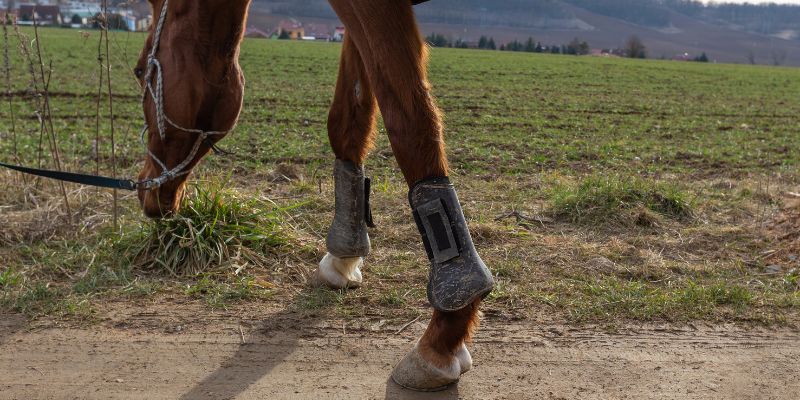
Hind limbs: Consist of the
- Pool,
- Femur with
- kneecap,
- lower leg bone,
- ankle,
- cannon bone,
- fetlock joint and
- Toe limb.
A special feature of the horse's legs is the movable kneecap, which allows the horse to fix the knee joint without expending energy, for example when sleeping or dozing.
This overview of horse anatomy shows how the horse's complex structure, especially its bone structure, contributes significantly to the functionality and performance of these majestic animals.
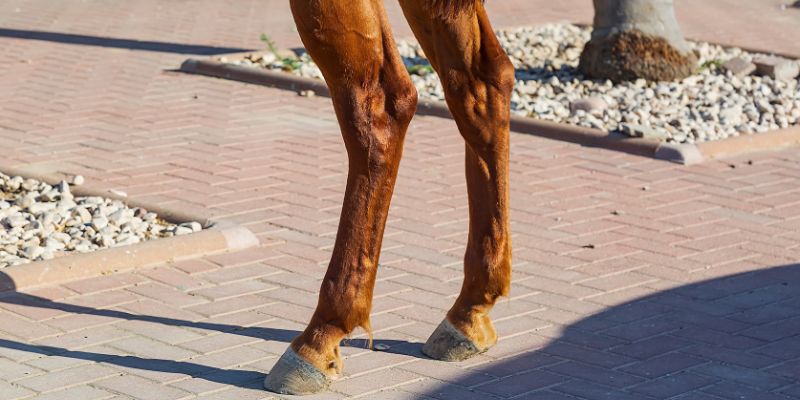
The different bone types in the horse's body and their functions
Your horse's skeleton consists of different types of bones , each of which has unique functions:
-
Long tubular bones: These are found, for example, in the cannon bone.
They are crucial for supporting the horse's body weight and serve as a lever for the muscles, which is essential for the horse's mobility. They also enable effective distribution of forces during movements such as running and jumping.
-
Short, cube-shaped bones: Found, for example, in parts of the ankle. These bones are often located in joints, where they provide stability and support.
They enable complex joint movements and contribute to shock absorption.
-
Flat bones: Like the bones of the skull, flat bones provide protection for vital organs and serve as anchor points for muscles.
They are also important for blood formation because they contain bone marrow.
-
Sesamoid bones: For example, the sesamoid bones. These small bones are located near joints and play an important role in movement and shock absorption.
They also help reduce friction in joints and protect tendons from wear and tear.
The role of minerals in bone structure
Minerals are essential for your horse's health and well-being. They play a crucial role in building and maintaining bone structure.
Here are some of the most important minerals for bone mineralization and their functions:
-
Calcium: One of the best-known minerals for bone health and bone development in horses.
It is crucial for building and maintaining strong bones and teeth. Calcium not only supports bone growth but is also important for muscle contractions and blood clotting.
-
Phosphorus: Works closely with calcium to promote healthy bone growth and development.
Phosphorus also supports energy metabolism in the body.
-
Magnesium: Another important mineral that plays a significant role in regulating blood sugar levels and helping to reduce stress.
Magnesium is also crucial for bone structure and muscle function.
-
Zinc: Essential for bone healing and development. It supports collagen formation and is crucial for bone mineralization.
Zinc plays an important role in the immune system and wound healing.
-
Copper: Essential for the formation of collagen and elastin, which are important for the strength and flexibility of bones and joints.
Copper is also important for iron absorption and energy metabolism.
-
Manganese: Required for the formation of chondroitin sulfate, a key component of cartilage and bone tissue.
Manganese is also important for bone formation and the metabolism of amino acids, cholesterol and carbohydrates.
Nutritional tips for horses with bone damage
Bone damage in horses is a serious matter, but the good news is that the horse's well-being can be positively influenced by proper nutrition .
The importance of a balanced mineral intake for horses
✔ Mineral-rich diet: Your horse's bones consist of approximately 25% water , organic matter, and inorganic minerals, with calcium, phosphorus, and magnesium being the main components. Additionally, trace elements such as manganese, copper, silicon, boron, iron, potassium, sodium, chlorine, and fluorine are important for bone development.
In horses with bone damage, care should therefore be taken to ensure an adequate supply of these minerals and trace elements.
✔ Adaptation to immobility: When horses have to be immobilized due to bone damage, decalcification of the bones begins. This cannot be prevented by supplemental calcium supplementation, as their calcium needs are already met through roughage.
Rather, it is important to adapt the diet to meet the need for non-energy-providing nutrients and trace elements that are essential for regeneration and healing.
✔ Be careful with calcium-rich mineral feeds: Calcium-rich mineral feeds, which are often used in breeding, are unsuitable for horses with bone damage, as calcium can displace important trace elements such as zinc, manganese or copper.
These trace elements are essential for the regeneration of connective tissue and bone.
✔ Oil feeding: During the horse's resting phase, it is advisable to provide essential fatty acids through oil feeding. These help combat inflammation and support the healing process. Suitable oils include linseed, salmon, wheat germ, hemp, borage, and black cumin oil.
Magnesium vs. Calcium: Which mineral is better for bones?
When considering horse bone health, it is important to understand the roles of magnesium and calcium in the horse's body:
➽ Calcium: An essential component of bone tissue that contributes to bone strength and structure. Calcium is crucial for bone growth and development, especially in young horses.
➽ Magnesium: This mineral plays an important role in bone formation and nerve and muscle conduction. It activates enzymes and is involved in the conversion of ATP to ADP, a key process for energy production in the horse's body. Magnesium is also stored in bones and teeth and makes up almost 12% of bone mass.
Both calcium and magnesium are essential for bone health, and it's important to ensure a balanced ratio of both in the horse's diet. Calcium and magnesium go hand in hand, working together to promote strong and healthy bones.
An unbalanced intake of either mineral can quickly lead to deficiencies and health problems.
How does the bone matrix work in horses?
The bone matrix is an integral part of the bone structure in horses and plays a central role in their functionality and health:
-
Living tissue: Contrary to the common belief that bones are rigid and lifeless , they are in fact living, metabolically active structures .
They are in a constant cycle of building and breaking down, which enables their adaptability and healing capacity.
-
Structure of the bone matrix: This consists of a thick outer layer of bone and an inner core of bone trabeculae. The spongy filling material contributes to stability without adding weight to the bone and protects against deformation. The sensitive periosteum, crisscrossed by nerves and blood vessels, surrounds each bone.
Larger bones also contain bone marrow, which is essential for blood formation.
-
Constant buildup and breakdown: The bone matrix is subject to a continuous process of buildup and breakdown. Osteoblasts (bone-forming cells) and osteoclasts (bone-degrading cells) play an important role in this. In addition to mucopolysaccharides (gel-like lubricants) and collagen fibers (tensile and resilient structural proteins), trace elements such as copper, manganese, and silicon are also important for bone formation and regeneration.
-
Importance of nutrients: The health of the bone matrix is closely linked to the availability of nutrients. An adequate supply of minerals and vitamins is therefore crucial for maintaining bone integrity and promoting regenerative capacity in the event of injury or disease of the skeletal system.
-
Interaction with other body structures: The bone matrix interacts closely with other parts of the body, especially with muscle tissue and joints.
This interaction is crucial for the horse’s overall mobility and resilience.
Conclusion
At Pferdegold, we know that the right balance of minerals and nutrients is essential for your horse's bone health.
The bone skeleton of a horse is a fascinating structure that combines strength and flexibility and is crucial for your horse's mobility and performance.
Horse bones are living tissue that requires constant care and a balanced diet.
FAQ
How many bones does a horse have?
The question "How many bones does a horse have?" is fascinating because it provides insight into the complex anatomy of these animals.
The average horse has approximately 205 bones, although the exact number can vary. These bones form the skeleton, which is crucial for movement, organ protection, and support functions. A horse's bone structure is adapted to efficiently distribute weight and forces during running, jumping, and other movements.
Every bone, from the large femurs to the smaller bones in the hooves, plays an important role in the overall system.
Can overtraining affect bone growth in young horses?
Overtraining can actually affect bone growth in young horses. Young horses, whose skeletons are not yet fully developed, are particularly susceptible to damage from excessive loading. Overtraining can lead to stress fractures and other bone damage.
It's important to carefully monitor the training of young horses and ensure it's appropriate for their developmental stage. Excessive stress during this critical growth phase can have long-term effects on the horse's bone structure and overall health.
How does bone health change in older horses?
With age, bone density and strength decrease in both humans and horses, making them more susceptible to fractures and other bone problems. Therefore, osteoarthritis and other degenerative joint diseases are common in older horses.
These changes arise from the deterioration of the cartilage between the bones, which leads to increased friction and inflammation and pain in the joints. The progression of osteoarthritis can be promoted by acute or chronic overload, trauma, and inflammation.
Therefore, it's important to carefully monitor the health and nutrition of older horses. A diet rich in essential minerals and vitamins can help support bone strength. Regular, but gentle, exercise can also be crucial for keeping joints supple and bones strong.
Learn more about horse health and discover our next guides!
- Calcium for horses: strengthening bones and muscles
- Feeding horses optimally and naturally » That's what matters!
- Manganese for horses explained: effects, deficiency & dosage
- Vitamin D for horses: Everything you need to know!
- Magnesium for horses: The key to healthy nerves
- Zinc for horses » The importance for horse health
